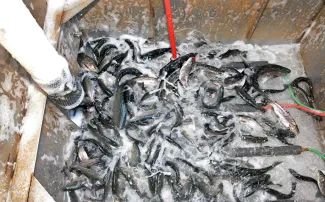
Best Oklahoma Fishing Tips . . . No Trout About It!
While Oklahoma supports two year-round trout fisheries, the Lower Illinois River and Lower Mountain Fork River, most anglers start thinking about trout when Oklahoma’s six seasonal trout areas open on November 1. These areas include:
Trout are stocked at these areas every two weeks from November 1 through March. Trout are cold water species and thrive during the wintertime months in Oklahoma, while traditional warm water species such as bass, crappie, catfish and sunfish are relatively inactive.
There are three effective methods for catching trout in Oklahoma: cast and retrieve, bottom fishing and fly fishing.
CAST & RETRIEVE
The basic setup for trout when using a cast and retrieve approach is a six foot to seven foot medium- to medium-lite action rod and a reel spooled with six- to eight-pound monofilament line. The most effective lure in my opinion for catching trout at all of the state’s trout fishing areas is a 1/16 ounce Vibric Rooster Tail in olive (frog). Rooster Tails in olive, brown, black or white are tried and true. Super Dupers in gold, silver or trout work well as do Little Cleo spoons in gold and orange or silver and orange. Make sure to keep your lure selection in a 1/8 to 1/16 ounce range. Simply cast your lure out and steadily reel in the line with a slow retrieve.
BOTTOM FISHING
The basic setup for trout when using a bottom fishing approach is a six foot to seven foot medium- to medium-lite action rod and a reel spooled with six- to eight-pound monofilament line. This method requires you to find a singular spot and cast to that spot. You will rig the end of your line with a snap swivel, sinker, bait holding snell hook and powerbait. For still water you will want to use a ¼ ounce sinker and a ½ ounce sinker for moving water. The snelled hook should be size 6, 8 or 10. I prefer purple nymph for powerbait, but most colors/flavors are effective. You will thread the end of your line through the eyelid of the sinker and tie off to the eyelid of the snap swivel. You will then open the snap on the swivel and attach the looped end of the snell hook’s line to the swivel and snap shut. You will then dab a chunk of the powerbait on your finger and work it around the hook, creating a ball or teardrop shape, until the hook is completely covered. When you cast to your spot, reel up the slack until the line is tight to the tip of the rod and either hold onto the rod or set it in a rod holder. Trout tend to peck at the bait instead of engulfing it all at once so when the tip of your rod is indicating a bite, grab the rod and wait for either a steady “thump, thump, thump” or just constant pressure on the line before setting the hook.
FLY FISHING

The basic setup for trout when using a fly fishing approach is a five- to six-weight rod with floating line, nine foot 4x leader and four feet of 5x tippet. If you plan on dry fly fishing in Oklahoma for trout, you need to be able to match the hatch. Contacting a local fly shop is the best way to get up-to-date information on what bugs are hatching and where/when. For nymph fishing, size 16 and smaller pheasant tails, copper johns, bloody marys, lightning bugs, rubber-leg yellow sallys and San Juan worms are all effective in flowing water. Strip fishing is best with a bead head wooly bugger in olive, brown, black or white. I prefer a size 6-8 olive bead head wooly bugger when fly fishing the state’s trout waters.
Always make sure to check the current fishing regulations before hitting the water!